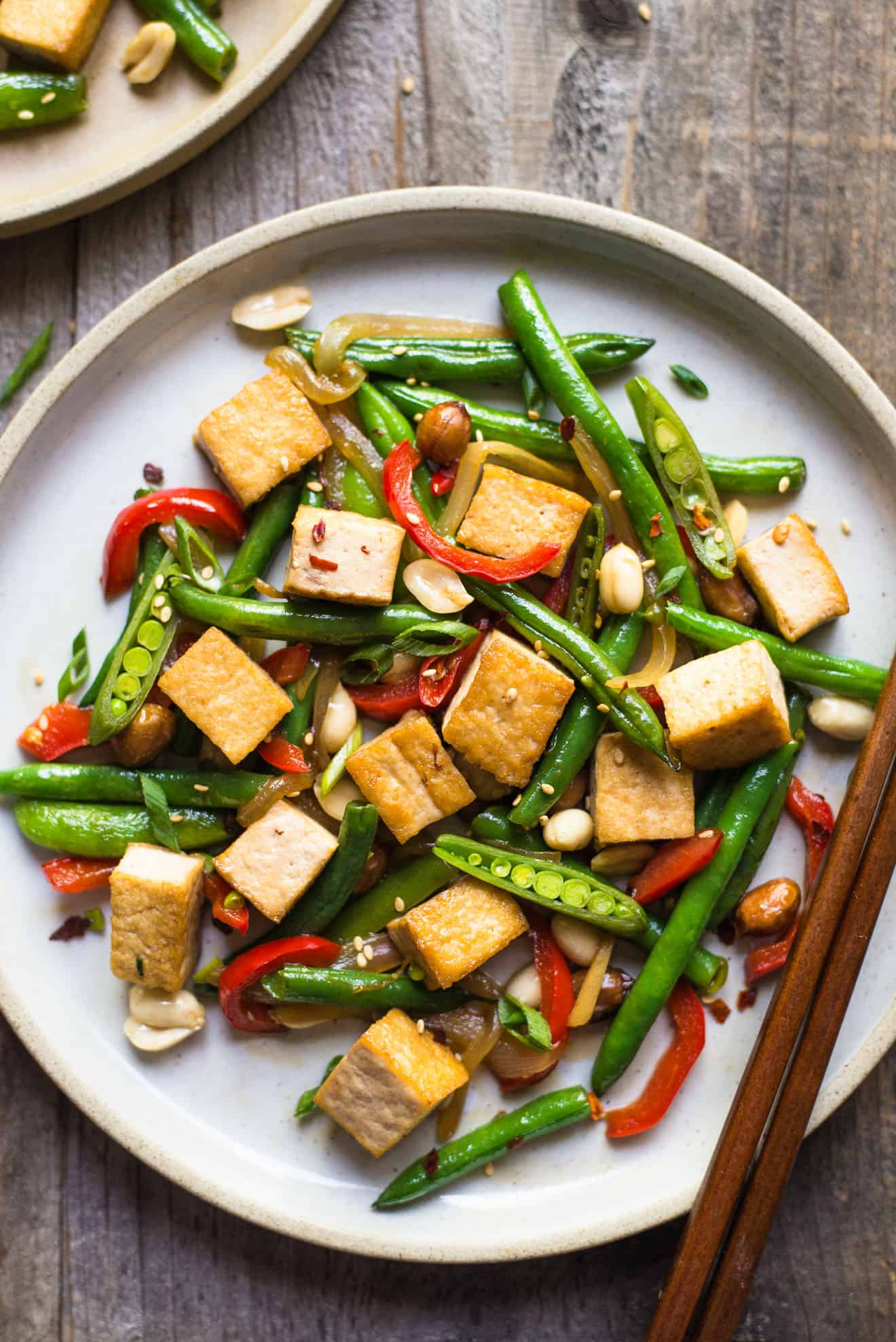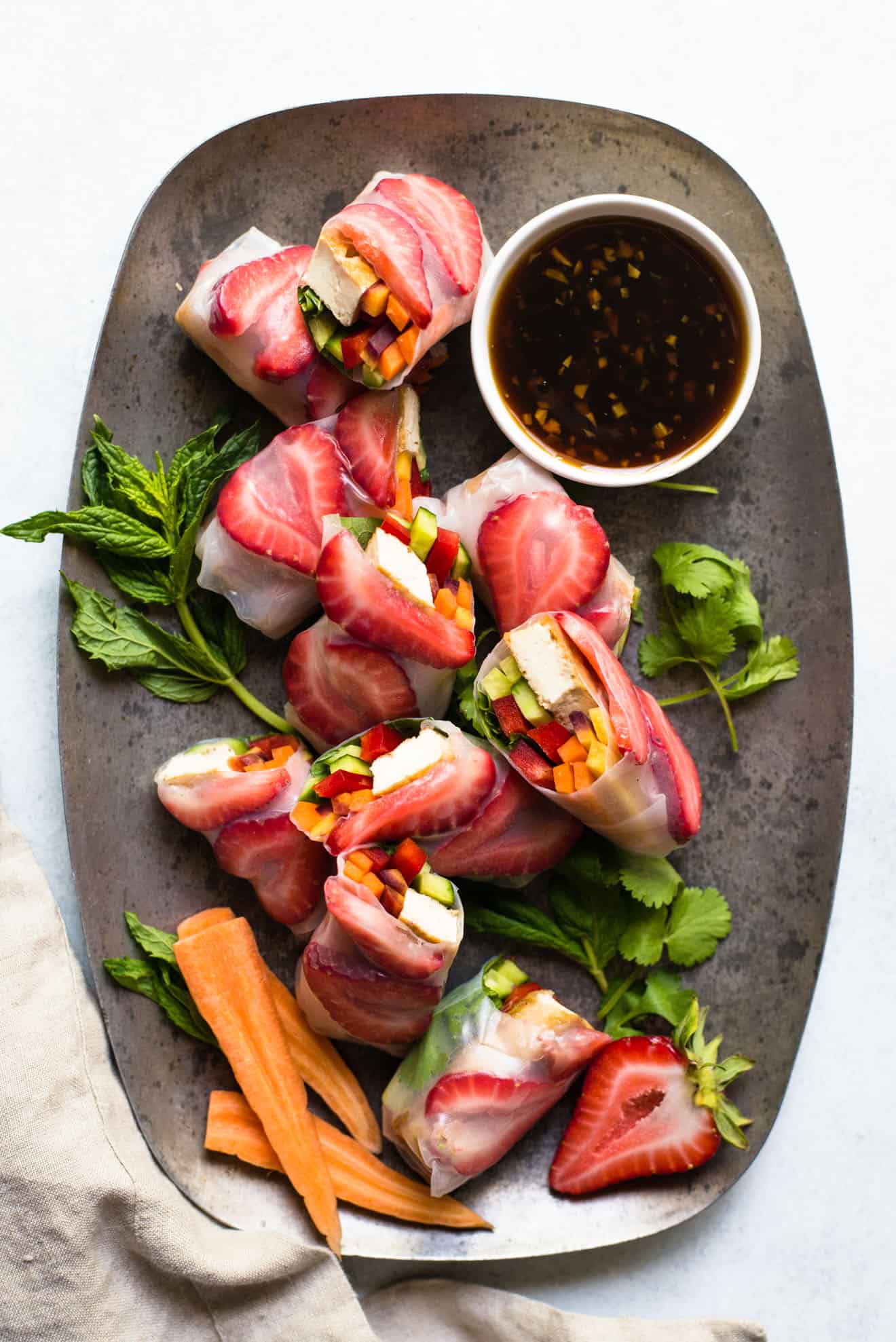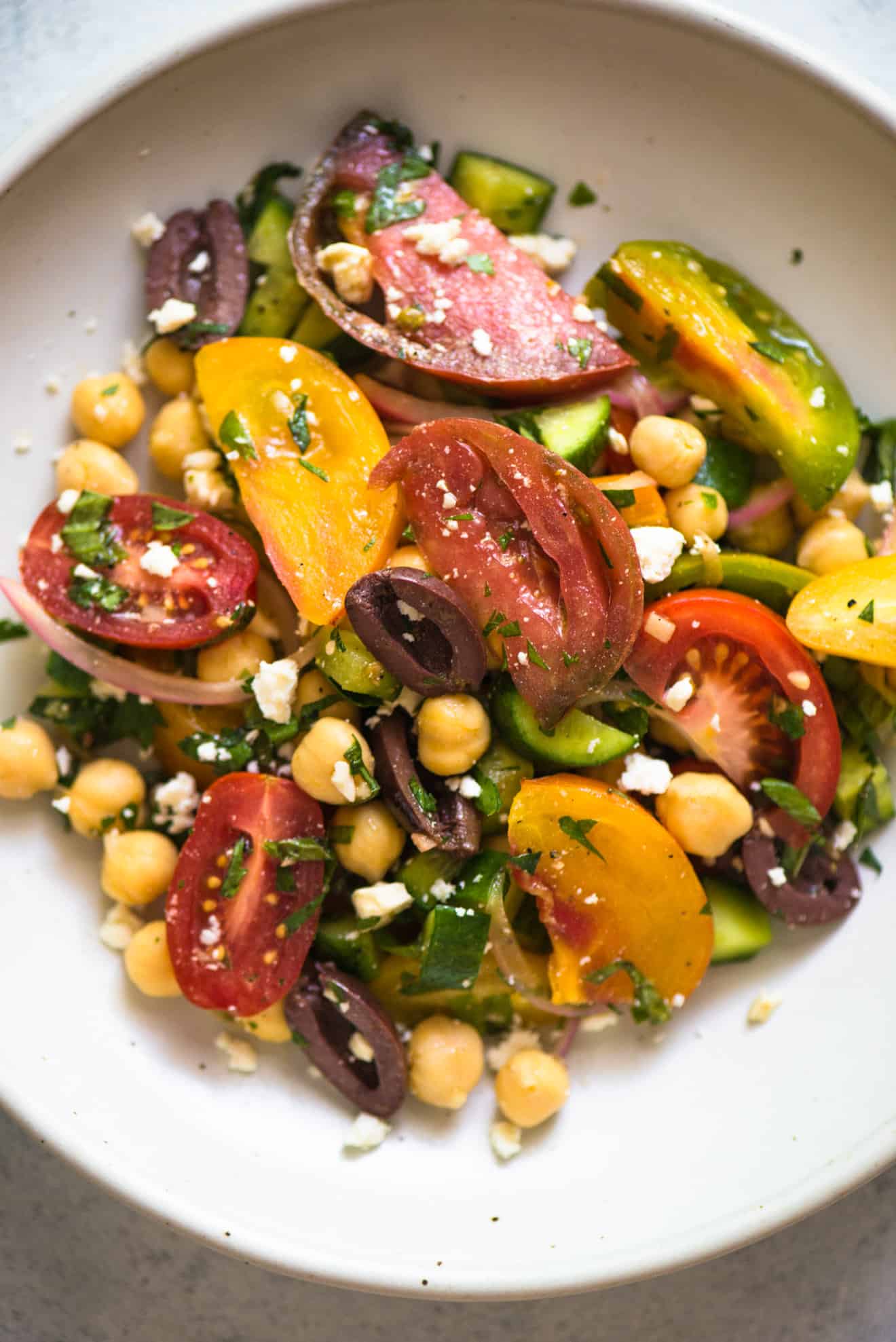Your July produce guide is here! Find out what’s in season in this month, along with tips on how to pick and store the produce. Get some recipe ideas, too!
In my opinion, summer is the best time for produce because so many fruits and vegetables are now in season! I find myself eating my weight in fruit this time of the year and I do so with no regrets. Soft, leafy herbs are also in season, and I always keep several bunches around my house for salads and stir fries.
Without further ado, here’s the July produce guide!
AVOCADOS
Even though we can find avocados in the supermarket year-round (usually from Mexico or South America), California avocados are in season now. Unless you are planning to use the avocado right after you buy it, you’re better off buying an avocado that’s slightly firm and letting it ripen on your counter for a few days. Ripe avocados turn brown or black quite quickly, so you should eat them within a day.
Besides using avocados for guacamole and salads, I love mixing 1/4 or 1/2 of an avocado in my smoothies to make the more smooth and filling.
- Cajun-Spiced Baked Salmon with Avocado Lime Sauce
- Baked Avocados with Fresh Salsa (from Floating Kitchen)
- Charred Broccoli and Tofu Stuffed Avocados with Sweet Lemon Curry Sauce (from The First Mess)
- Chilled Avocado Soup with Plum Pico de Gallo (from Will Frolic For Food)
- Avocado Chocolate Mousse Parfaits
BEANS
When you’re picking green beans or any other type of string beans, pick the ones that look crisp and do not have a lot of brown spots on them. Store them in a plastic bag in the refrigerator. Condensation tends to build up in plastic bags in the refrigerator. If you are not going to eat the beans in a few days, slip a sheet of paper towel in the bag to absorb extra moisture.
- Green Bean Farro Salad (from What’s Gaby Cooking)
- Roasted Green Beans with Vinegary Dill Sauce (from Our Four Forks)
- Mediterranean Three Bean Salad
- Green Beans with Almond Pesto (from Smitten Kitchen)
- Miso Maple Green Bean Salad with Bacon
BLUEBERRIES
Pick blueberries that are vibrant blue. Try not to pick the ones that have wrinkled skin. Store the blueberries in a sealed container that’s lined with a sheet of paper towel. Be sure to sift through the berries and throw out any that have moldy or mushy bits.
I love eating blueberries because they are high in fiber and Vitamins C and K!
- Blueberry Frozen Yogurt
- Blueberry Kamut Salad with Mint Yogurt Dressing (from The Seasoned Vegetable)
- Wild Blueberry Earl Grey Smoothie Bowl with Fresh Lemon-Vanilla Yogurt (from Kumquat)
- Simple Berry Smoothie (from A Beautiful Plate)
- Blueberry Corn Chicken Salad with Maple Dressing (from Eating Bird Food)
CHERRIES

When buying red cherries, such as Bing cherries, pick ones that have a deep red color. It’s generally a sign that the cherries are ripe.If you are buying Rainier cherries (the yellow cherries), choose ones that look shiny and smooth without too many brown spots on them. Also, try picking cherries with green stems—it’s an indication of freshness. The stems will turn brown and woody over time. Store cherries in a plastic bag in the refrigerator. If you have a lot of cherries to go through, rinse and remove the cherry pits and freeze the cherries for smoothies. I usually line a baking sheet with parchment or wax paper and lay the fruit on top.
- Skinny Cherry & Lime Leaf Margaritas (from Hola Jalapeño)
- Steak Tacos with Cherry Pico de Gallo (from The Kitchen Paper)
- Cherry Lime Red Beet Smoothie
- Cherry Bourbon BBQ Sauce (paleo)
KITCHEN TIP: HOW TO PIT CHERRIES WITHOUT A PITTER
CORN
When you are picking ears of corn, squeeze the tip to see if it is filled with corn kernels. I like picking smaller ears of corn because the kernels tend to be much more tender and juicy. I don’t shuck the corn before refrigerating them because the husks help prevent the kernels from drying out. Once I cut off the kernels from the corn, I collect the corn cobs and freeze them in a bag to make vegetable broth (along with other vegetable scraps).
- Slow Cooker Corn and Potato Soup
- Grilled Corn and Berry Hummus Flatbread (from Running to the Kitchen)
- Vaghareli Makai (Spiced Indian Corn (from David Lebovitz)
- Grilled Corn and Feta Egg in a Hole Avocado Toast (from Half Baked Harvest)
- Spicy Fish Tacos with Grilled Corn Slaw & Avocado Coriander Sauce (from The Brick Kitchen)
CUCUMBERS

Pick cucumbers that look vibrant green (or yellow, if you’re picking lemon cucumbers) and don’t have much wrinkled skin. I typically buy Persian or English cucumbers because their skin and seeds are quite tender. I usually store cucumbers in a paper bag and then place that bag into a plastic bag. The paper bag helps absorb moisture from condensation. Cucumbers should be consumed within 4 to 5 days.
- Sesame Ginger Miso Cucumber Salad (from Snixy Kitchen)
- Cucumber Mint Smoothie (from Happy Healthy Mama)
- Moroccan Watermelon Cucumber Salad with Pistachio (from Feasting at Home)
EGGPLANT

Choose eggplant that are firm with little or no brown spots on the outside. Also, check the tops of the eggplant. If the eggplant is still fresh, the tops will not be dried and shriveled. You can actually store eggplant at room temperature for a day or two. If you still haven’t used the eggplant yet, store them in the refrigerator in a plastic bag.
- Roasted Eggplant with Garlic Yogurt and Za’atar (from Foolproof Living)
- Eggplant Bliss Bowl with Mint and Cilantro Chutney
- Pickled Eggplant Mediterranean Bowl with Faux-lafel (from Brewing Happiness)
- Grilled Tenderloin and Eggplant Open-Faced Caprese Sandwiches (from Floating Kitchen)
GREENS
Pick the bundles of greens that are still vibrant—if you see yellowness in the greens, it’s an indication that they are beyond their prime. When I buy bunches of kale or collard greens, I typically strip the leaves off the stems, rinse and spin the leaves in a salad spinner. I then lay the leaves on a baking sheet lined with a tea towel and let them dry for about 30 minutes. I’ll then refrigerate them in plastic bags. This tiny bit of prep work usually makes cooking much more pleasant throughout the week.
- Green Shakshuka with Kale and Collard Greens
- Kale Paneer (from Cook Republic)
- Tahini Mint Kale Salad (from The Full Helping)
- Arugula Avocado Salad with Lemon Vinaigrette (from Andie Mitchell)
- Spinach Salad with Toasted Pita & Hazelnuts
SOFT HERBS
Many tutorials I’ve seen online recommend sticking herbs into a glass jar or cup filled with water and covering everything with a plastic bag. Some websites will say to store the covered herbs on your kitchen counter or the refrigerator. The problem with storing them in the counter, I’ve found, is that you’ll attract a lot of fruit flies (especially basil). On the other hand, the problem with storing them in the fridge is that I don’t usually have the space. That’s why I wrap a damp paper towel around the stem of the herbs and wrap everything in a plastic bag. I’ll tie the opening of the bag with a rubber band and refrigerate the herbs.
- Cold Cucumber Basil Soup with Peach and Tomato Salsa (from The Green Life)
- Vegetarian Carrot Top Pesto Pasta with Zucchini Noodles
- Spicy Thai Mint Julep (from Honestly Yum)
- Feta, Basil and Spring Onion Muffins (from Salted Plains)
- Quinoa Tabbouleh
KOHLRABI
Usually, kohlrabi are sold in supermarkets without their greens. Pick the ones that still look green (or purple) on the outside without much brown spots. Wrap them in a plastic bag and store them in the refrigerator for up to a week or two. If you are lucky enough to find kohlrabi with their greens still in tact, don’t throw the greens away! You can cook them like collard greens!
- Leek and Kohlrabi Fritters
- Spicy Kohlrabi Noodles (from Love and Lemons)
- Kohlrabi, Corn & Tofu Curry (from Oh My Veggies)
- Curried Millet Stir Fry with Kohlrabi
- Curried Kohlrabi Fries (from Dishing Up the Dirt)
PEAS (SUGAR, SNOW)
Pick sugar peas or snow peas that are vibrant green with smooth skin. Store them in a plastic bag and keep them in your crisper drawer. I always string my sugar peas and snow peas before cooking them. It’s a habit I picked up from Mama Lin!
- Kung Pao Tofu Stir Fry
- Roasted Sugar Snap Peas with Mint (from With Food and Love)
- Shrimp with Snow Peas (from Simply Recipes)
- Green Bean and Sugar Snap Pea Salad (from Life is But a Dish)
- Rice Noodles with Shrimp & Snow Peas
STONE FRUIT

When you’re picking peaches or nectarines, choose the ones that have some red skin around the neck. If the skin around the stem looks completely yellow or white, it’s an indication that they were picked off the tree before the optimal time. Ripe peaches and nectarines will have some give when you squeeze them and the skin should be deep red. Ripe plums, pluots or apricots will also have some give and fell quite soft on the top. I usually buy stone fruit with varying degrees of ripeness. That way, I’ll have some ready to eat and can leave the rest to ripen over the next few days.
- Gluten-Free Pluot Torte
- Peach Baked Muesli (from Heartbeet Kitchen)
- Peaches and Cream Vegan Chia Pudding (from Cotter Crunch)
- Gluten-Free Strawberry Nectarine Crisp (from Minimalist Baker)
- Summer Stone Fruit Crisp (from Oh She Glows)
STRAWBERRIES
When I’m picking strawberries, I always go for the basket that have the least mount of whiteness around the stem. It’s an indication that the strawberries are ready to eat. Store strawberries in a sealed container lined with paper towels. Do not rinse the berries before you store them—this can cause the berries to turn mushy. I usually hull my strawberries and throw away the tops. After reading this article, I’m going to save them for my smoothies!
- Teriyaki Tofu Spring Rolls
- Creamy Millet Porridge with Roasted Strawberries (from Naturally Ella)
- Strawberry Mint Bourbon Smash (from Hungry Girl Por Vida)
- Strawberry Mint Limeade Popsicles (from Uproot Kitchen)
- Grilled Salmon with Strawberry Salsa (from The Roasted Root)
SUMMER SQUASH

Pick summer squash that are shiny and have vibrant color on the outside. They can be stored at room temperature for a day or two. After that, store them in plastic bag inside the crisper drawer in your refrigerator.
- Zucchini Corn and Tomato Salad with Avocado Lime Dressing (from Vanilla and Bean)
- Zucchini, Arugula and Feta Frittata (from The Roasted Root)
- Grilled Summer Squash Boats (from Healthy Seasonal Recipes)
- Summer Squash Peach Kisses (from Heartbeet Kitchen)
- Turmeric Zucchini and Potato Fritters
TOMATOES
Pick tomatoes that have a vibrant color and taut skin. Store them at room temperature. If you notice that mushy spots are starting to form at the bottom of the tomatoes, eat them immediately or store them in the refrigerator for another day or two.
- Greek Salad with Heirloom Tomatoes and Chickpeas
- Summer Squash Pasta with Pesto and Chickpeas (from The Year In Food)
- Tomato Tart with Scallion and Goat Cheese Filling (from O & O Eats)
- Spaghetti with Fried Eggs, Cherry Tomatoes and Roasted Red Peppers (from Eats Well With Others)
- Burst Tomato and Zucchini Spaghetti with Avocado Sauce (from Pinch of Yum)













Aysegul Sanford says
Thank you so much for featuring my recipe as well. This is such a helpful guide. I have already pinned a few recipes to try before the season is over.
Thanks again. Cheers!
Lisa Lin says
You are so welcome, lady!